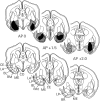Amygdalar lesions block discriminative avoidance learning and cingulothalamic training-induced neuronal plasticity in rabbits
- PMID: 9185561
- PMCID: PMC6573294
- DOI: 10.1523/JNEUROSCI.17-13-05237.1997
Amygdalar lesions block discriminative avoidance learning and cingulothalamic training-induced neuronal plasticity in rabbits
Abstract
Learning to fear dangerous situations requires the participation of neurons of the amygdala. Here it is shown that amygdalar neurons are also involved in learning to avoid dangerous situations. Amygdalar lesions severely impaired the acquisition of acoustically cued, discriminative instrumental avoidance behavior of rabbits. In addition, the development of anterior cingulate cortical and medial dorsal thalamic training-induced neuronal plasticity in the early stages of behavioral acquisition was blocked in rabbits with lesions. The development of training-induced neuronal plasticity in the medial dorsal and anterior thalamic nuclei in late stages of behavioral acquisition was also blocked in rabbits with lesions. These results indicate that the integrity of the amygdala is essential for the establishment of both early and late training-induced cingulothalamic neuronal plasticity. It is hypothesized that amygdalar training-induced neuronal plasticity in the initial trials of conditioning represents a substrate of learned fear, essential for the early and late cingulothalamic plasticity that is involved in mediation of acquisition of the instrumental avoidance response.
Figures





Similar articles
-
Medial geniculate, amygdalar and cingulate cortical training-induced neuronal activity during discriminative avoidance learning in rabbits with auditory cortical lesions.J Neurosci. 2001 May 1;21(9):3271-81. doi: 10.1523/JNEUROSCI.21-09-03271.2001. J Neurosci. 2001. PMID: 11312312 Free PMC article.
-
Medial geniculate lesions block amygdalar and cingulothalamic learning-related neuronal activity.J Neurosci. 1997 Nov 1;17(21):8645-55. doi: 10.1523/JNEUROSCI.17-21-08645.1997. J Neurosci. 1997. PMID: 9334434 Free PMC article.
-
Lesions in the central nucleus of the amygdala: discriminative avoidance learning, discriminative approach learning, and cingulothalamic training-induced neuronal activity.Neurobiol Learn Mem. 2001 Nov;76(3):403-25. doi: 10.1006/nlme.2001.4019. Neurobiol Learn Mem. 2001. PMID: 11726245
-
Synaptic transmission and plasticity in the amygdala. An emerging physiology of fear conditioning circuits.Mol Neurobiol. 1996 Aug;13(1):1-22. doi: 10.1007/BF02740749. Mol Neurobiol. 1996. PMID: 8892333 Review.
-
Parallels between cerebellum- and amygdala-dependent conditioning.Nat Rev Neurosci. 2002 Feb;3(2):122-31. doi: 10.1038/nrn728. Nat Rev Neurosci. 2002. PMID: 11836520 Review.
Cited by
-
Prefrontal-limbic Functional Connectivity during Acquisition and Extinction of Conditioned Fear.Neuroscience. 2018 Apr 15;376:162-171. doi: 10.1016/j.neuroscience.2018.02.022. Epub 2018 Feb 22. Neuroscience. 2018. PMID: 29477695 Free PMC article.
-
The impact of prenatal alcohol exposure on social, cognitive and affective behavioral domains: Insights from rodent models.Alcohol. 2016 Mar;51:1-15. doi: 10.1016/j.alcohol.2015.12.002. Epub 2016 Jan 11. Alcohol. 2016. PMID: 26992695 Free PMC article. Review.
-
Amygdala involvement in human avoidance, escape and approach behavior.Neuroimage. 2010 Nov 1;53(2):769-76. doi: 10.1016/j.neuroimage.2010.06.058. Epub 2010 Jun 30. Neuroimage. 2010. PMID: 20600966 Free PMC article.
-
Activation of phasic pontine-wave generator prevents rapid eye movement sleep deprivation-induced learning impairment in the rat: a mechanism for sleep-dependent plasticity.J Neurosci. 2004 Feb 11;24(6):1416-27. doi: 10.1523/JNEUROSCI.4111-03.2004. J Neurosci. 2004. PMID: 14960614 Free PMC article.
-
Medial geniculate, amygdalar and cingulate cortical training-induced neuronal activity during discriminative avoidance learning in rabbits with auditory cortical lesions.J Neurosci. 2001 May 1;21(9):3271-81. doi: 10.1523/JNEUROSCI.21-09-03271.2001. J Neurosci. 2001. PMID: 11312312 Free PMC article.
References
-
- Aigner TG, Walker DL, Mishkin M (1991) Comparison of the effects of scopolamine administered before and after acquisition in a test of visual recognition memory in monkeys. Behav Neural Biol [erratum (1991) 55:380] 55:61–67. - PubMed
-
- Applegate CD, Frysinger RC, Kapp BS, Gallagher M. Multiple unit activity recorded from amygdala central nucleus during Pavlovian heart rate conditioning in rabbit. Brain Res. 1982;234:251–262. - PubMed
-
- Blanchard DC, Blanchard RJ. Innate and conditioned reactions to threat in rats with amygdalar lesions. J Comp Physiol Psychol. 1972;81:281–290. - PubMed
-
- Brady JV, Schreiner L, Geller I, Kling A. Subcortical mechanisms in emotional behavior: the effect of rhinencephalic injury upon the acquisition and retention of a conditioned avoidance response in cats. J Comp Physiol Psychol. 1954;47:179–186. - PubMed
-
- Brogden WJ, Culler FA. A device for motor conditioning of small animals. Science. 1936;83:269. - PubMed
Publication types
MeSH terms
Grants and funding
LinkOut - more resources
Full Text Sources
